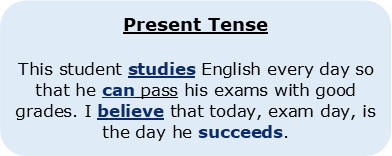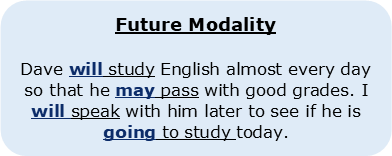Is it true there are only two verb tenses in English?

This is the first of three chapters about Verb Tense. To complete this reader, read each chapter carefully and then unlock and complete our materials to check your understanding.
– Discuss how tense can be identified on verbs in English
– Explore how many tenses exist and how to identify them
– Explain why English has no future tense
Before you begin reading...
-
video and audio texts
-
knowledge checks and quizzes
-
skills practices, tasks and assignments
Chapter 1
Of all the word types in English, verbs must surely be the most complicated. Not only are verbs the keystones of a clause or sentence, but they can be modified to express grammatical features such as modality, transitivity, passivity, agreement and aspect. In this short three chapter reader, we focus on verb tense (the expression of fixed time) in both general and academic contexts.
Because some students report having difficulty with knowing when and how to use this time-based verb function, we focus on the two English tenses in this course in some detail. We explore the past and present tenses in Chapter 1, the formation of these two tenses in Chapter 2 and their use in academic English essays in Chapter 3. After completing each lesson, you may wish to unlock, download and complete our worksheets to check your progress and understanding and improve your academic English proficiency. Good luck!

1. How is tense identified in a language?
Ask native speakers, tutors and students alike how many tenses there are in the English language and you’ll no doubt receive a variety of different answers. Some might say three, some might say twelve, and most people probably won’t know for sure. That’s because grammar is theoretical, and how we identify tense can vary.
Most people know that tense is something that happens with ‘verbs’ and ‘time’, but some think that any expression of time is related to tense – but this isn’t technically true. The confusion surrounding tense is probably due to the fact that there are three verb functions which relate to time: tense, aspect and modality.
- tense expresses a fixed position in time; it is shown by changes in form to the first verb in a verb phrase: (learn > learned)
- aspect expresses periods of time; it is shown by adding new verbs to the verb phrase and by making changes to the main verb: (learn > is learning; has learned)
- modality expresses past and future possibilities and hypotheticals; it is shown by adding new verbs or adverbs to the verb phrase: (learn > will learn; could learn)
2. Which tenses does English have?
As is explained above, tense is the expression of a fixed point in time. It is shown by making changes to the form of the first verb in a verb phrase. This means that English has only two tenses, the past and the present.


As can be seen in the above examples, the past tense is commonly formed by attaching an ‘-ed’ suffix to the end of a verb (studied/succeeded) regardless of who is doing the action of that verb. For the present tense, however, the suffix ‘-s’ is only visible on a verb when third-person singular subjects ‘he’, ‘she’ and ‘it’ are responsible for that verb’s actions (I succeed/he succeeds).
3. Is there no future tense in English?
By this definition of tense, the answer is no – there is no future tense in English. This is because the future is not expressed by changes made to the form of a verb. Instead, to express the future, we can add modal verbs (such as ‘will’ or ‘may’) to the beginning of the verb phrase. This verb function is called verb modality:



Whether tutors overgeneralise the word ‘tense’ because it’s easier for their students or because they aren’t aware of aspect and modality is down to an individual’s experience, background and preferences. Most English-language tutors, particularly those from an EFL background, will probably call the above twelve patterns tenses because that’s more straight-forward to learn. However, because tense, aspect and modality all function differently and possess different rules, we believe that it’s beneficial for students to learn them both independently and in combination.
Continue on to Chapter 2 of this reader on verb tense to learn more about correctly forming the past and present tenses in English and how they’re used in academic contexts. We’ll also be looking in detail at the one-hundred-and-fifty most common academic regular and irregular verbs.
Downloadables
Once you’ve completed all three chapters in this short reader about Verb Tense, you might then wish to download our Chapter Worksheets to check your progress or print for your students. These professional PDF worksheets can be easily accessed for only a few Academic Marks.
Chapter 1 explores the topic: Is it true there are only two verb tenses in English? Our Chapter 1 Worksheet (containing guidance, activities and answer keys) can be accessed here at the click of a button.
Chapter 2 explores the topic: How are present and past tense verbs formed? Our Chapter 2 Worksheet (containing guidance, activities and answer keys) can be accessed here at the click of a button.
Chapter 3 explores the topic: How is verb tense used in academic English essays? Our Chapter 3 Worksheet (containing guidance, activities and answer keys) can be accessed here at the click of a button.
To save yourself 2 Marks, click on the button below to gain unlimited access to all of our Verb Tense Chapter Worksheets. This All-in-1 Pack includes every chapter, activity and answer key related this to topic in one handy and professional PDF.
Collect Academic Marks
-
100 Marks for joining
-
25 Marks for daily e-learning
-
100-200 for feedback/testimonials
-
100-500 for referring your colleages/friends